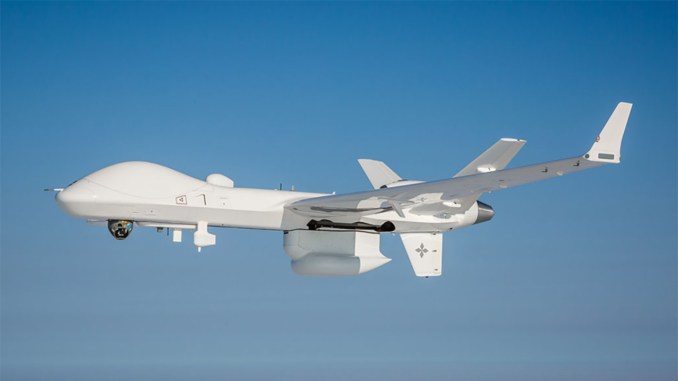
Given the increasing naval activities by China and Russia, the Japan MoD is exploring UAVs’ capabilities to take over the vigilance and surveillance.
Japan and the U.S. appear to be moving fast to strengthen aerial surveillance in the ECS (East China Sea) with new drone presence in Japan’s southeastern island chains and the seas around Taiwan’s northeast. An MQ-9B SeaGuardian UAV (Unmanned Aerial Vehicle) landed at Kanoya Air Base in Japan’s Kagoshima Prefecture, the base announced on Jun. 14, 2024 on X.
“A long-distance UAV (MQ-9B Sea Guardian) landed at Kanoya Air Base from Hachinohe Air Base for the first time, and took off the next day,” the post said. The video showed the Sea Guardian, with its distinctive SeaVue XMC radar bulge under the rear fuselage, landing at the base and then taking off the next day. Both the bases are operated by the JMSDF (Japan Maritime Self-Defense Force).
滞空型UAV(MQ-9B シーガーディアン)が八戸航空基地から鹿屋航空基地に初めて着陸し、翌日離陸しました。#海自 #無人機 #鹿屋市 #シーガーディアン pic.twitter.com/iWRhXHbzoo
— 海上自衛隊 第1航空群 (@jmsdf_1aw) June 14, 2024
This could possibly be part of a test of the system that Japan had announced would happen this year.
Reports say Japan has not yet purchased the drone, but has been conducting exhaustive trials with the developer, GA-ASI (General Atomics Aeronautical Systems Inc.). Prior to that, Japan’s Kadena Air Base in Okinawa received another MQ-4C Triton on Jun. 9, Okinawa Times reported. The first flight of the type from the base happened on May 20.
JMSDF is testing the MQ-9B SeaGuardian
On Feb. 16, 2024, Japan’s defense minister Minoru Kinara announced during a press conference the trial campaign to be carried out with the MQ-9B SeaGuardian over the ECS from July to September, USNI reported. The country had been conducting trials of the drone at the JMSDF Hachinohe airbase since May of last year, said the minister.
Kinara added that during the upcoming test from July to September, the SeaGuardian will operate from JMSDF Kanoya Air Base (located on the main island of Kyushu), and respond to a “simulated alert surveillance over the ECS.” “[This will be] carried out three times as part of the trials,” the report added. Kyushu is just north of the Nansei (or Ryukyu) island chain, whose islands are located in a southwesterly direction, with the last island, Yonaguni, roughly 100 km off Taiwan’s Yilan county, on its far northeast.
As Kanoya’s statement said the drone returned the next day, the drone landing there doesn’t appear to be related to the announced trials, although it could have been done to validate the UAV’s long distance flight capability. Testing the MQ-9B for its maritime surveillance capability with its various optical, electronic, radar surveillance, communications and navigation equipment that have to work in tandem, would be a far more extensive and longer task.
The landing at Kanoya therefore could just be a test run prior to the simulated alert trials. Hachinohe is almost at the northernmost part in Aomori Prefecture, on the eastern seaboard facing the western Pacific. The drone traveled nearly a 2,000 km distance south to Kanoya.
Another possibility is that the JMSDF has simply advanced the schedule. This however seems unlikely. While the actual purpose behind the flight cannot be ascertained, it appears that the flight from Hachinohe to Kanoya is laying the groundwork before the primary tests.
Experimenting with unmanned ‘eyes’ on Chinese, Russian navies
A Jul. 10, 2023 report on Japan Forward said the JMSDF revealed the Sea Guardian to the media for the first time on Jun. 21, 2023, after it had been undergoing test operations since 2022. “Given the increasing naval activities by China and Russia, the Defense Ministry is exploring the possibility of UAVs taking over the vigilance and surveillance tasks traditionally performed by human-piloted patrol planes,” the report added.
The Sea Guardian is a highly sophisticated UAV, also capable of ASW (Anti-Submarine Warfare) and EW (Electronic Warfare) with a minimum endurance of 24 hours to a maximum of 40 hours, depending on the payload. The drone is 11.8 meters (38.7 feet) long and has a wingspan of 24 meters (78.7 feet), and it can cover a cruising distance of approximately 4,300 kilometers (2,322 nautical miles).
“At present, a US company is operating the SeaGuardian drone, provided by a contracted supplier, on behalf of the JMSDF. The JMSDF intends to conduct 2,000 hours of test flights by Sept. 2023. The aim is to determine the extent to which the UAV can assume the tasks currently carried out by patrol planes,” the report added. Journalists were given access to the UAV’s ground control station where they saw the feeds on the screen from the drone’s optical and electronic sensors.
The JMSDF Kanoya Air Base, meanwhile, had previously hosted eight U.S. Air Force MQ-9 Reapers from Nov. 2022 to Nov. 2023. The UAVs were subsequently relocated to Kadena Air Base on Okinawa. Kanoya is also home base to JMSDF Fleet Air Wing 1, whose P-1s and P-3C Orions maritime patrol aircraft “routinely track and shadow Russian Navy and People’s Liberation Army Navy (PLAN) ships passing through or conducting operations around Japan’s southwest islands,” USNI added.
Second Triton lands at Kadena, Okinawa
The two U.S. Navy Tritons at Kadena air base will be based there until October, and are expected to soon commence intelligence, surveillance and reconnaissance (ISR) missions around Japan’s southwest islands, USNI said. This comes after PLA Navy warships transited through Japan’s southwest islands on Jun. 9. The Aviationist had also reported that a Chinese JH-7 fighter-bomber and a Z-19 helicopter approached and circled a Dutch warship, the HNLMS Tromp, on Jun. 7, 2024.
Second US Navy MQ-4C Triton arrived at Kadena Air Base in Japan on June 9. Two MQ-4C Tritons parked in hangar at Kadena where first aircraft flew in on May 20.
Since October last year, eight US Air Force MQ-9 Reapers have been deployed at Kadena.https://t.co/aONtdMIDdW pic.twitter.com/RyOhivQyXk
— Ryan Chan 陳家翹 (@ryankakiuchan) June 9, 2024
A public explainer by the Japan MoD explained how the drones were required amid the severe security environment, warranting a strengthening of the ISR (Intelligence, Surveillance and Reconnaissance) capabilities of the US-Japan alliance. ISR is needed particularly in the “southwestern region of Japan.”
The document also stated that this is the third time Tritons have been deployed to Japan, with the first deployment from May to Oct. 2021 at Misawa Air Base, and the second from July to Oct. 2022 at Marine Corps Air Station Iwakuni. The two Tritons are also not the only US unmanned ISR UAVs at Kadena; eight US Air Force MQ-9 Reapers have been stationed there since Oct. 2023 on an indefinite period of deployment.
“Kadena’s strategic position makes it an invaluable location to stage ISR operations, enabling access to numerous potential flashpoints across the Indo-Pacific region,” stated a USAF release about the Reapers’ arrival at Kadena at the time.
- SEO Powered Content & PR Distribution. Get Amplified Today.
- PlatoData.Network Vertical Generative Ai. Empower Yourself. Access Here.
- PlatoAiStream. Web3 Intelligence. Knowledge Amplified. Access Here.
- PlatoESG. Carbon, CleanTech, Energy, Environment, Solar, Waste Management. Access Here.
- PlatoHealth. Biotech and Clinical Trials Intelligence. Access Here.
- Source: https://theaviationist.com/2024/06/16/mq-9b-seaguardian-lands-for-first-time-at-kanoya-ab/




